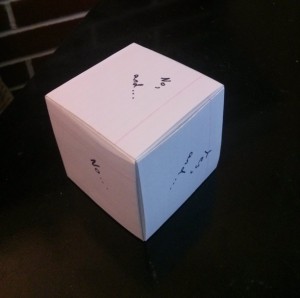https://www.rpgsolo.com/ has a table for resolving yes/no questions, in turn taken from FU RPG. Roll a die:
- Yes, and…
- Yes…
- Yes, but…
- No, but…
- No…
- No, and…

Their example:
I listen at the door. Do I hear anything? (I determine the odds are 50/50 so I click the “50/50” button in the Get Answer section and I get back the following.)
Yes, and…
(Now it’s up to me to determine what that means. Since it says “and” that means I got some kind of bonus. So I am going to interpret that to mean that from the sounds I am hearing I have received some extra information. So I type or say to myself),
I hear one person in the room. (Now I ask my next question.) Is the door locked?
No, but…
(The answer is no but it’s not a total loss. I interpret what that means then type the following),
The door seems weak enough that I can probably kick it open.
So we’ve gotten a base system for telling stories. We then added the following:
- Whenever you roll a result, roll TWICE. In one universe, you get one result. In the other universe, you get another result. (With accompanying description). If you have more than three universes lying around, discard down to three. All actions/questions are for a particular universe declared by the players.
- (addendum) Actually, roll two dice: only split the universe if the second die comes up “1” or “2”. Otherwise, answer the question normally. This speeds things up a bit.
It was pretty fun in practice. I recommend using a text file over paper, since you’re going to do a lot of copy-paste. We had more fun with no GM than with a GM. No firm result yet on sandbox-worldbuilding vs players in scenarios; both seemed all right.
